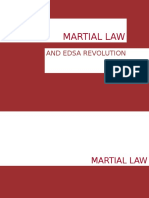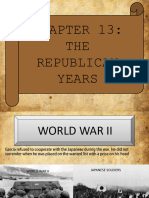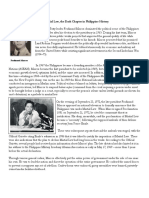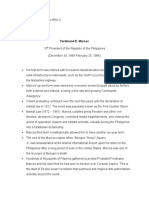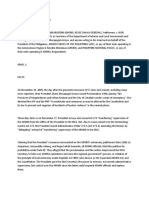03 Handout 1
03 Handout 1
Uploaded by
rhiangidaCopyright:
Available Formats
03 Handout 1
03 Handout 1
Uploaded by
rhiangidaOriginal Title
Copyright
Available Formats
Share this document
Did you find this document useful?
Is this content inappropriate?
Copyright:
Available Formats
03 Handout 1
03 Handout 1
Uploaded by
rhiangidaCopyright:
Available Formats
SH1688
BATAS MILITAR
I. Two (2) Alleged Plans of Marcos to Extend his Terms
A. Plan A - to make the Philippine government a parliamentary system.
B. Plan B - to declare Martial Law or Batas Militar.
II. Important Details in Creation of Martial Law
A. Oplan Sagittarius
• It is considered by Senator Aquino to be the blueprint or detailed plan how to execute
Martial Law.
• Romeo Espino wrote the original report of the plan. He refuted Aquino’s claim by saying
that Oplan Sagittarius is just an emergency plan on how to utilize the Armed Force of the
Philippines (AFP).
B. Rolex 12
• It is the name given to the group who helped Marcos on his plan regarding Martial Law.
• The name was based on the story that each member of group received a Rolex watch.
• The members were:
1. Defense Minister Juan Ponce Enrile
2. Gen. Fabian Ver of National Intelligence Security Authority – Head of Presidential
Security
3. Gen. Romeo Espino – Chief of Staff of Armed Force of the Philippines
4. Gen. Fidel Ramos – Chief of the Philippine Constabulary (PC)
5. Gen. Rafael Sagala – Chief of Philippine Army
6. Gen. Ignacio Paz – Chief of the Intelligence Services of the Armed Force of the
Philippines
7. Gen. Jose Rancudo of the Philippine Air Force
8. Gen. Tomas Diaz of Philippine Constabulary
9. Gen. Alfredo Montoya – Chief of the Metropolitan Command (METROCOM)
10. Gen Hilario Ruiz- of the Philippine Navy
11. Colonel Romeo Gatan – Commander of Philippine Constabulary in Tarlac
12. Eduardo “Danding” Conjuangco – Governor of Tarlac
III. Events Leading to the Proclamation of Martial Law
A. Plaza Miranda Bombing
• On August 21, 1971, during the campaign rally of the Liberal Party at Plaza Miranda, two
(2) grenades exploded causing hundreds of civilians and politicians to be injured.
• Senator Benigno “Ninoy” Aquino, a liberal candidate and mortal enemy of Marcos, was
not harmed since he was not yet at the place during the incident. Because of this, he was
accused as an accomplice of the communist group in the bombing incident. On the other
hand, many believe that it was Marcos who planned the infamous incident.
• Because of the Plaza Miranda bombing, Marcos suspended the Privilege of Writ Habeas
Corpus. The suspension allowed authorities to arrest anyone without the need of presenting
him/her to a judicial body. The suspension was immediately revoked by Marcos due to the
protest of the Filipinos.
03 Handout 1 *Property of STI
Page 1 of 2
SH1688
• Aside from Senator Aquino, Marcos primarily accused the Communist Party of the
Philippines (CPP) headed by Jose Maria Sison for the series of bombing events. The CPP
was formed December 26, 1968. After three (3) months, the CPP formed another group
named New People’s Army (NPA). The previous “Huks” of Hukbo Mapagpalaya ng
Pilipinas, an armed group located in Central Luzon, helped in the formation of NPA.
B. Natural Calamities (July-August 1972)
• A typhoon during the months of July-August 1972 caused a great flood in Central Luzon
destroying the agricultural crops.
• The government was forced to import almost half a million of tons of rice product.
• This caused for the prices of other product to rise.
• The student, once again, protested the increase of prices.
C. Constitutional Convention (Con-Con)
• The convention was established to replace the 1935 Constitution, which was made when
the Philippine was still under the colonial rule of America.
• Due to manipulation of the current administration, social and economic reform were set
aside.
• Instead, the focus of Con-Con is to change the presidential system of government into a
parliamentary system.
• Napoleon Rama, a delegate from Cebu, proposed a resolution to prohibit Marcos from
running for a third term which the majority of the convention supported.
• Eduardo Quintero, a delegate of Leyte, exposed that Imelda Marcos tried to influence the
Con-Con by giving money to the delegates.
• The Con-Con passed a Transitory Provision, a provision stating that during the transition
to parliamentary system, all executive and legislative power will be exercised by the current
administration – Marcos regime.
D. Enrile’s Ambush
• On September 22, 1972, reports regarding the ambush of Defense Minister Enrile
circulated.
• According to Enrile, he was saved from the ambush because he rode the car of his
bodyguards instead of his car.
• 14 years later, Enrile would confirm that the ambush was fake.
IV. Proclamation No. 1081
A. On September 23, 1972, President Marcos declared Proclamation No 1081 or the declaration
of the Martial Law.
B. According to Marcos, the purpose of the proclamation was to save the republic and reform the
society.
C. Though the proclamation happened a day after Enrile’s ambush, official papers with his
signature showed that Marcos put the Philippines under Martial Law as early as September 21,
1972.
Reference:
Magsanoc-Alikpala, K. (1997). Batas militar. Retrieved from https://www.youtube.com/watch?v=SG2Mx7Y5vzc
03 Handout 1 *Property of STI
Page 2 of 2
You might also like
- Readings in Philippine History Unit 6.1: The American Period in The Philippines Spanish American Secret AgreementDocument24 pagesReadings in Philippine History Unit 6.1: The American Period in The Philippines Spanish American Secret AgreementApril BumanglagNo ratings yet
- Pam 1-15 - OespaDocument374 pagesPam 1-15 - OespaCyrus James Silvestre100% (3)
- History of Martial LawDocument5 pagesHistory of Martial LawAxis ZoidNo ratings yet
- Corruption Extravagance and Brutality History Documentary Dlt.Document54 pagesCorruption Extravagance and Brutality History Documentary Dlt.Diana Louise ToribioNo ratings yet
- Module 7 - Martial LawDocument59 pagesModule 7 - Martial LawmigzislandNo ratings yet
- Martial Law Discussion-1Document33 pagesMartial Law Discussion-1Leilani Ca�aNo ratings yet
- What Is Martial Law?Document2 pagesWhat Is Martial Law?Alvin TolentinoNo ratings yet
- Group 7 (Martial Law)Document12 pagesGroup 7 (Martial Law)LeaNo ratings yet
- History Martial LawDocument14 pagesHistory Martial LawRomarie Robeso BadillaNo ratings yet
- Martial Law ReflectionDocument7 pagesMartial Law ReflectionVon Steven OrtizNo ratings yet
- Martial LawDocument23 pagesMartial LawYrwin ManibogNo ratings yet
- Martial LAWDocument31 pagesMartial LAWJohnpatrick VeranaNo ratings yet
- Historical DetailsDocument3 pagesHistorical DetailsMinori UeharaNo ratings yet
- Ferdinandmarcosslideshare-161115141926 2Document23 pagesFerdinandmarcosslideshare-161115141926 2leah.taculanganNo ratings yet
- MARTIAL LAW NewDocument35 pagesMARTIAL LAW NewjoshivanmejalaNo ratings yet
- Martial LawDocument32 pagesMartial LawMarie PenianoNo ratings yet
- Martial LawDocument22 pagesMartial LawJohnlove BadalNo ratings yet
- Chap 22Document2 pagesChap 22Rozel Joy LabasanoNo ratings yet
- The Philippines Under Pres MarcosDocument2 pagesThe Philippines Under Pres MarcosJaimy SchoolNo ratings yet
- MARCOSDocument8 pagesMARCOSSwelyn Angelee Mendoza BalelinNo ratings yet
- Group 4Document23 pagesGroup 4Zyreign Sheen MallorcaNo ratings yet
- What Is Martial Law?Document5 pagesWhat Is Martial Law?Drey TabilogNo ratings yet
- Group 7 Declaration of Martial Law by President Ferdinand MarcosDocument27 pagesGroup 7 Declaration of Martial Law by President Ferdinand Marcosjerome.No ratings yet
- Martial Law WikiDocument21 pagesMartial Law WikiAllen BeatoNo ratings yet
- The Period of The Fourth Republic of The PhilippinesDocument32 pagesThe Period of The Fourth Republic of The PhilippinesTrisha Anne Aranzaso BautistaNo ratings yet
- Batas Militar Part IDocument12 pagesBatas Militar Part IGenesis GuerreroNo ratings yet
- The Republican Years (Part 2)Document32 pagesThe Republican Years (Part 2)migzislandNo ratings yet
- Lesson Plan ABDocument2 pagesLesson Plan ABAnne Janelle Guan75% (4)
- Assignment Phil. Hist.: Saint Louis Unversity School of NursingDocument9 pagesAssignment Phil. Hist.: Saint Louis Unversity School of NursingCharm TanyaNo ratings yet
- Martial Law During and PostDocument6 pagesMartial Law During and PostLeoncio BocoNo ratings yet
- Martial Law - The Dark Chapter in Philippine HistoryDocument4 pagesMartial Law - The Dark Chapter in Philippine HistoryMarjorie CoNo ratings yet
- The Original People Power EDSADocument113 pagesThe Original People Power EDSAgreatbluemarlin250% (2)
- Declaration of Martial LawDocument11 pagesDeclaration of Martial LawAlyson Fortuna100% (1)
- Martial LawDocument2 pagesMartial LawShannise Dayne ChuaNo ratings yet
- Martial LawDocument11 pagesMartial LawJona Reyes100% (1)
- Video Task 3Document5 pagesVideo Task 3Debbie Dapito CabilaoNo ratings yet
- Martial Law ImpositionDocument3 pagesMartial Law ImpositionBea BordadoraNo ratings yet
- Declaration of Martial Law in 1972Document8 pagesDeclaration of Martial Law in 1972Jerome AvilaNo ratings yet
- Commonwealth Government Group 3 UpdatedDocument24 pagesCommonwealth Government Group 3 UpdatedRobinNo ratings yet
- Commonwealth Government of The PhilippinesDocument20 pagesCommonwealth Government of The PhilippinesLalangGalia100% (2)
- People Power RevolutionDocument16 pagesPeople Power RevolutionRondave MalpayaNo ratings yet
- Dark Chapter of The Philippines: Martial LawDocument2 pagesDark Chapter of The Philippines: Martial LawJohn Marcel CruzNo ratings yet
- Philippine History: Early LifeDocument7 pagesPhilippine History: Early LifeJuliux Solis GuzmoNo ratings yet
- Martial Law in The PhilippinesDocument7 pagesMartial Law in The PhilippinesJemar LoretoNo ratings yet
- Lesson 7Document10 pagesLesson 7englaterrazoebNo ratings yet
- CHAPTER 23 Handouts - Readings in Philippine HistoryDocument3 pagesCHAPTER 23 Handouts - Readings in Philippine HistoryDagoy, Meguela Angela B.No ratings yet
- Martial Law Under Ferdinand Marcos - Wikipedia PDFDocument97 pagesMartial Law Under Ferdinand Marcos - Wikipedia PDFGillian mae GarciaNo ratings yet
- IntroductionDocument2 pagesIntroductionChristian James GuevaraNo ratings yet
- Rsu SMC HistoryDocument32 pagesRsu SMC Historyrenn67011No ratings yet
- Speech of Cory Aquino PPT2Document51 pagesSpeech of Cory Aquino PPT2Darlene CarmonaNo ratings yet
- The Problem and Its Background: Manila LawDocument16 pagesThe Problem and Its Background: Manila LawShaaaaaai0% (1)
- History Unit 9 & 12Document10 pagesHistory Unit 9 & 12Isabel FlonascaNo ratings yet
- CFLM 200Document32 pagesCFLM 200Tabaosares JeffreNo ratings yet
- RPHDocument2 pagesRPHElla Mae MalabananNo ratings yet
- Politika - Roxas, Quirino, MagsaysayDocument13 pagesPolitika - Roxas, Quirino, MagsaysayDiane AlmarioNo ratings yet
- 1.1 Group 1 RPH Report PDFDocument9 pages1.1 Group 1 RPH Report PDFwag pleaseNo ratings yet
- The Declaration of Martial Law: Proclamation No. 1081Document17 pagesThe Declaration of Martial Law: Proclamation No. 1081Cherry Mae Morales BandijaNo ratings yet
- Instructional PackageDocument6 pagesInstructional PackageMayflor Curib CubosNo ratings yet
- MARCOSDocument10 pagesMARCOSAmeenah Eiy CyNo ratings yet
- Lea Board ExamDocument47 pagesLea Board ExamAya Vanessa AuayangNo ratings yet
- NSTP ReviewerDocument3 pagesNSTP ReviewerEmerson Paul S. CabungcalNo ratings yet
- Sept07.2013solons Seek Replacement of Presidential Security Group (PSG) With Government Protection and Security Service (GPSS)Document2 pagesSept07.2013solons Seek Replacement of Presidential Security Group (PSG) With Government Protection and Security Service (GPSS)pribhor2No ratings yet
- HANDOUT Military HistoryDocument2 pagesHANDOUT Military Historybernard100% (1)
- Rocamora DiscontentPhilippines 1991Document30 pagesRocamora DiscontentPhilippines 1991Rogelio Alicor PanaoNo ratings yet
- Gudani v. Senga, G.R. No. 170165Document11 pagesGudani v. Senga, G.R. No. 170165Daryl CruzNo ratings yet
- Method of Instruction 2017 MAPUA ROTCDocument17 pagesMethod of Instruction 2017 MAPUA ROTCJohn Michael Blancaflor100% (1)
- Group 3 - OPORD Bakunahan Sa Norte - Final Output-15Jan22Document92 pagesGroup 3 - OPORD Bakunahan Sa Norte - Final Output-15Jan22Marlon MejiaNo ratings yet
- National Service Training Program: 1987 Philippine Constitution PreambleDocument79 pagesNational Service Training Program: 1987 Philippine Constitution PreambleJuven BarcelonNo ratings yet
- Interior Guard DutyDocument6 pagesInterior Guard DutyAna Ramos Lopez100% (1)
- Crisis ManagementDocument42 pagesCrisis ManagementPSS PRO12No ratings yet
- AFP Awards and DecorationsDocument57 pagesAFP Awards and Decorationsace yapNo ratings yet
- Republic v. Sandiganbayan (GR 104768)Document14 pagesRepublic v. Sandiganbayan (GR 104768)Anne Meagen ManingasNo ratings yet
- AFP Identifies 19 Cadavers in Crashed C-130 AircraftDocument1 pageAFP Identifies 19 Cadavers in Crashed C-130 AircraftRapplerNo ratings yet
- Kapunan Vs de VillaDocument2 pagesKapunan Vs de VillaAnaliza AlcoseroNo ratings yet
- Camiguin Polytechnic State College Rotc UnitDocument33 pagesCamiguin Polytechnic State College Rotc UnitgomonyNo ratings yet
- Armed Forces of The Philippines Medical CenterDocument5 pagesArmed Forces of The Philippines Medical CenterRoeder Max PangramuyenNo ratings yet
- CyberparkHoldings Inc.Document22 pagesCyberparkHoldings Inc.Homer SebastianNo ratings yet
- Datu Zaldy Uy Ampatuan, Ansaruddin Adiong, Regie Sahali-Generale, Petitioners, V. Hon. Ronaldo PunoDocument4 pagesDatu Zaldy Uy Ampatuan, Ansaruddin Adiong, Regie Sahali-Generale, Petitioners, V. Hon. Ronaldo Punomelbertgutzby vivasNo ratings yet
- Section 5 Afp and Pa OrganizationDocument104 pagesSection 5 Afp and Pa OrganizationAngel TubatNo ratings yet
- Theories of Public ServiceDocument47 pagesTheories of Public Serviceelio50% (2)
- Introduction To Philippine Criminal Justice System CHAPTERS I VIDocument47 pagesIntroduction To Philippine Criminal Justice System CHAPTERS I VIStephanie EnojoNo ratings yet
- Full Text RTC JurisdictionDocument16 pagesFull Text RTC JurisdictionJoshua ParilNo ratings yet
- Foreign PolicyDocument40 pagesForeign PolicyCrazy DaveNo ratings yet
- EVYLCDocument2 pagesEVYLCEf LawmeknowkeyNo ratings yet
- Philippine Public Administration PUAD 20243: Analyzing Selected Government OrganizationsDocument16 pagesPhilippine Public Administration PUAD 20243: Analyzing Selected Government OrganizationsKennethSampaguitaDeLaRosaNo ratings yet
- 004 MAKABAYAN 1 - Babala at Tuntunin PDFDocument23 pages004 MAKABAYAN 1 - Babala at Tuntunin PDFMyk Twentytwenty NBeyondNo ratings yet
- Marine Forces Reserve Central, Philippine Marine CorpsDocument18 pagesMarine Forces Reserve Central, Philippine Marine CorpsMarine Forces Reserve CentralNo ratings yet
- Lesson 2. Military OrientationDocument31 pagesLesson 2. Military OrientationPrincess PsychoNo ratings yet















